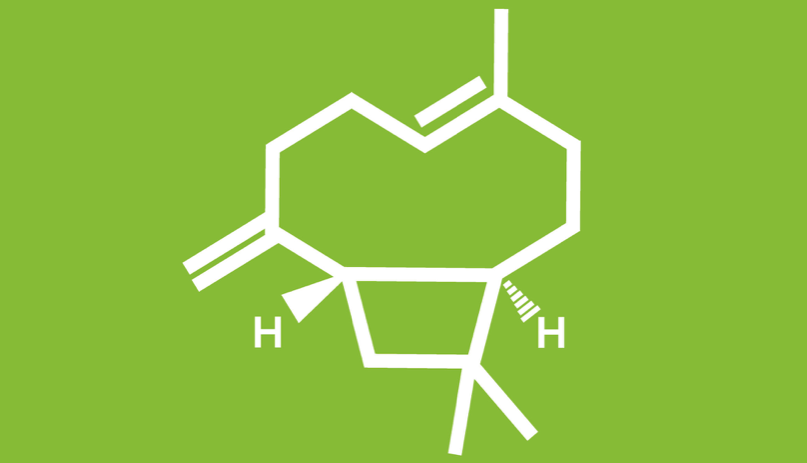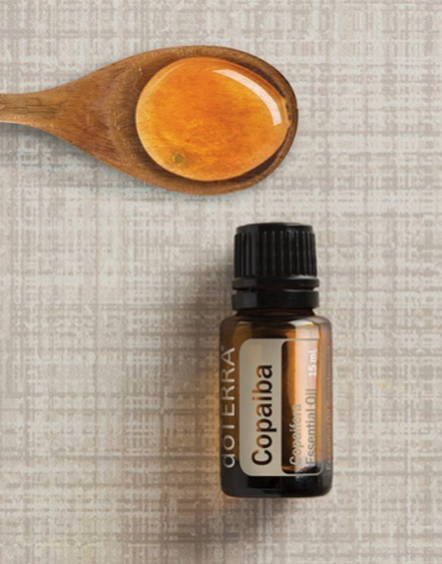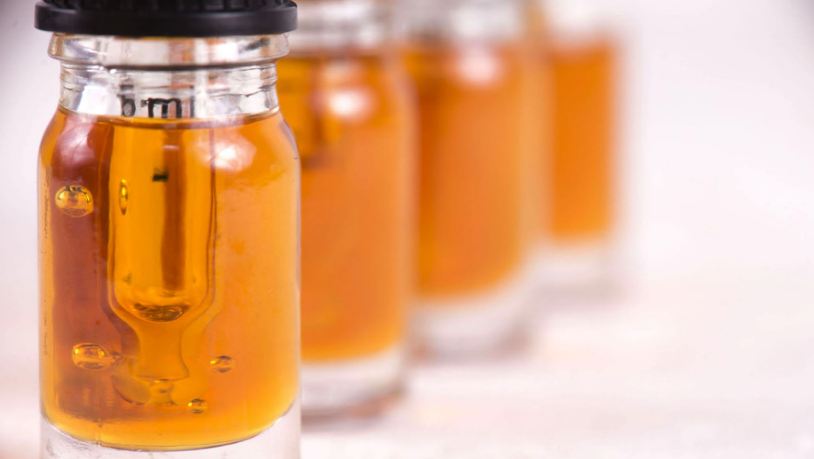doTERRA Copaiba Essential Oil
Copaiba essential oil is derived from the resin of the copaiba tree which can grow upwards of more than 100 feet and can be found in tropical South America.
Copaiba essential oil is derived from the resin of the copaiba tree which can grow upwards of more than 100 feet and can be found in tropical South America.
The Chemistry of Copaiba Copaiba’s main chemical component is beta-caryophyllene, a chemical similar to cannabinoids in Cannabis Protecting nerve cells and beneficial for the cardiovascular and immune systems. Uses Copaiba is a incredibly versatile oil that has been used for centuries. :
Plant Description Copaifera officinalis trees are evergreen trees native to Central and South America, where it flourishes best in tropical rainforest habitats (though it can grow in both wet and dry forests). The trees themselves are tall, and can grow to more than 100 feet tall. Sourcing The Amazon rainforest represents over half of the planet’s remaining rainforests. doTERRA is proud to partner with a large network of copaiba harvesters that sustainably collect their oleoresin and ensure that the trees will be around for years to come. Beta-CaryophylleneThe Endocannabinoid System The endogenous cannabinoid system (Endocannabinoid System), the namesake of the plant that led to its discovery, isn’t a controversial topic at all, but one of the most important physiologic systems involved in human health. As recent research is discovering, it is also one of the body systems that can be most positively influenced through the use of essential oils. Endocannabinoids and the receptors that they communicate with to induce physiological responses are found all throughout the body. Your brain, vital organs, immune cells, and even connective tissue contain endocannabinoid receptors, which are tasked with maintaining the stability of our body’s internal processes while dealing with fluctuations in the external environment. Immune response, inflammatory response, memory, and even appetite are influenced by these receptors. They are a vital link between the brain and the rest of the body, coordinating communication by different cell types. CB1 & CB2 Receptors While we speculate that there may be several different types of cannabinoid receptors, we have currently identified two different subtypes: CB1, which is expressed primarily on the nerve cells in the brain, and CB2, which is expressed predominantly on white blood cells within the immune system. Research has shown that CB1 activation influences memory processing and pain regulation, but it is also induces psychoactive effects.1 CB2 receptors support healthy nervous system function, proper immune function, and have soothing and relaxing properties on the body (similar to that of CB1), primarily through their ability to regulate inflammation.2,3 But perhaps most interesting, CB2 activation does not have the same psychoactive side effects as does its counterpart, CB1.4 Beta-Caryophyllene There is a breadth of research that suggests terpenoid compounds found in many essential oils can have a vast influence on these receptors, but the research is particularly strong in regards to one specific sesquiterpene. Recent research has demonstrated that the bicyclic sesquiterpene beta-caryophyllene has the ability to bind to CB2 receptors (5). What this means is that along with its cellular and skin-health supporting properties, due to its activation of CB2 receptors, beta-caryophyllene may also support healthy nervous and immune function, and have similar soothing and relaxing properties on the body (similar to that prompted by CB1 activation), without the potential psychoactive side effects.* While beta-caryophyllene is primarily known for its presence in the essential oils extracted from Black Pepper, Clove, Melissa, and Rosemary, the best source is actually the lesser-known oil Copaiba. GC-MS assessments have shown that many sources of Copaiba essential oil are composed of more than 50% beta-caryophyllene, and not surprisingly, the properties of this oil extracted from the oleoresin of Copaifera species trees is becoming a popular topic of research. There have been over 70 peer-reviewed studies published in scientific journals in the last few years evaluating the benefits of Copaiba, several of which focus on its CB2-binding properties and the associated health benefits. Conclusion Using various usage models, beta-caryophyllene-rich Copaiba essential oil, through its activation of CB2 receptors, has the ability to positively influence our health in ways we are just beginning to understand. doTERRA science blog articles are based on a variety of scientific sources. Many of the referenced studies are preliminary and further research is needed to gain greater understanding of the findings. Some articles offer multiple views on general health topics and are not the official position of doTERRA. Consult your healthcare provider before making changes to diet or exercise. A Chemist's Perspective: Cannabinoids, Cannabis, and Caryophyllene
Foreword It has come to my attention that there has been a lot of confusion recently surrounding the properties of cannabinoid compounds found in certain oils. Individuals with ties to the CBD oil industry would have you believe that beta-caryophyllene, a compound found in Copaiba oil and Black Pepper oil, is not a cannabinoid. The same individuals would also have you believe that cannabidiol (CBD) oil never contains the psychoactive compound tetrahydrocannabinol (THC) or any of its isomers. This is not surprising, because both of these claims promote the CBD oil industry. Unfortunately, this misinformation has been perpetuated to the point that many people are convinced that it is accurate, despite strong evidence to the contrary. I’ve prepared this article in hopes that I can set the facts straight. Having worked as a medicinal chemist for 15 years, I’ve learned a great deal about the chemical properties of all kinds of essential oils. I’ve even conducted my own chemical analyses of hemp, CBD, and cannabis oil in my lab at doTERRA. In this article, I will discuss the chemical properties of cannabinoid compounds found in the various cannabis oils and compare them with beta-caryophyllene. Beta-caryophyllene is the main compound found in Copaiba, doTERRA’s alternative to cannabis. Beta-Caryophyllene is a Cannabinoid There is a wealth of information available in the scientific literature regarding the classes of cannabinoid compounds and the receptors involved in the endocannabinoid system. For several years now, beta-caryophyllene has been known to be a cannabinoid. But don’t just take my word for it. Back in 2008, a study by J. Gertsch et al. rolled off the press with the unambiguous headline, “Beta-caryophyllene is a dietary cannabinoid.”1 The study was published in Proceedings of the National Academy of Sciences of the United States of America, a prestigious scientific journal. Since then, at least a dozen more papers have been published on the subject, reemphasizing the fact that beta-caryophyllene is a cannabinoid.2-13 By definition, a cannabinoid is any ligand, molecule, or class of molecules that acts on either or both of the currently identified cannabinoid receptors, CB1 and CB2. Interestingly, these two receptors produce significantly different physiological responses when activated. CB1 activation, caused by THC and other similar cannabinoids, results in a psychoactive drug high. On the other hand, CB2 activation by beta-caryophyllene (BCP) has produced results showing some promising therapeutic benefits. These include supporting a healthy inflammatory response, soothing discomfort, and positively affecting mood without the psychoactive side effects associated with other cannabinoids.2-4,10 It is true that the positive benefits associated with BCP have also been observed using other cannabinoids, such as THC, cannabidiol, and cannabinol, but using these compounds can also come with unwanted psychological effects, especially in the case of THC. Types of Cannabinoids There are three distinct classes of cannabinoids: endocannabinoids, phytocannabinoids, and synthetic cannabinoids. Synthetic cannabinoids are found in certain pharmaceutical products designed to help with glaucoma, appetite stimulation, antiemetics, and other disease-linked targets. Endocannabinoids, on the other hand, are produced naturally by the body. These molecules are mainly composed of amines and amides. Endocannabinoids are pharmacologically similar to some phytocannabinoids, but vary greatly in their chemical structure. This gives different endocannabinoids the ability to produce different neurological responses, even when administered in similar therapeutic doses. The primary function of endocannabinoids is to modulate normal physiological functions. The last class of cannabinoids is known as the phytocannabinoids. These are molecules that are produced by plants such as Cannabis and Copaifera. The Cannabis species produces the commonly known molecules THC and CBD, while the Copaifera plant family produces only BCP. Although BCP differs significantly from other cannabinoids in its structure, it nonetheless reacts selectively with the CB2 receptor, thus defining it as a cannabinoid.2 However, it is chemically distinct from other cannabinoids, which is why it cannot cause a positive result on a drug test. BCP is classified as a sesquiterpene based on its chemical structure and makeup. Research on BCP is ongoing and will continue to add to our understanding of its potential value. Cannabidiol (CBD) oil can contain the psychoactive tetrahydrocannabinol (THC) To be legally marketable, CBD oil is not supposed to contain any discernable amount of THC.14 However, our own internal investigation involving analytical testing and evaluation has found that various CBD oils on the market do contain significant levels of THC and therefore could very likely trigger a psychoactive response and/or positive drug test. Our evaluation has also shown that commonly purchased brands of CBD oil can vary greatly in their claimed CBD content. In fact, in some samples we were not able to identify the presence of any CBD at all. In contrast, my analyses have shown that doTERRA oils are 100% free of THC, and oil compositions are consistent between batches. Conclusion In summary, this article is not intended to be a complete picture of the benefits of beta-caryophyllene nor an outline of the properties of the endocannabinoid system. Rather, it is a statement of scientifically-accepted facts aimed to clear up the misleading information on the molecules in question. My hopes are that reading this article will help individuals in their personal research on cannabinoids and, most importantly, their decisions about which oils to use in their daily life. Dr. Cody Beaumont, PhD Director, Analytical Services & Quality Control |

Emotional well-being
Copaiba Unveiling Copaiba invites individuals to connect with their past. It offers a deep intertwining energy that links experience to experience to unveil the deeper meaning and messages showing up in one’s life. Copaiba respects the sacred sheltered withinuntil it is ready to emerge into the light of consciousness. It then invites individuals to become thoughtfully aware of the shadow aspects of themselves and discover who they really are. Individuals in need of Copaiba often find that vulnerable self-awareness work reveals unresolved pain in hidden recesses of their heart, mind and body. Many discover they are plagued with feelings of guilt, shame, inadequacy, or unworthiness that have seen absorbed from their early environment. These shame-based feelings distort every interaction they have with life. Everything seen through the filter of “less than” creates a perception of the world that is extremely painful and ultimatelydefeating. Copaiba offers assistance to those caught in lower vibrations of shame, blame, fear, and self-loathing, and other unconsciously internalised emotions. It summons them to begin the unravelling and restoration forlasting healing and further awareness and insight. Copaiba invites those who have done something that causes guilt or shame to undergo appropriate remorse and then move on, remembering that forgiveness of the self is necessary. If not dealt with, these lowest vibrational emotions will drive an individual to rebel or overcompensate. Both are a product of running from their centre of truth and existence. Acknowledging the reality of past choices and experiences allows individuals to grow and change in more conscious and clear ways. Copaiba also invites individuals to come to the Divine for clarity and redefinition.It reminds that the Divine knows them anciently as whole beings –from their earliest childhood wounds to their current limitations. The Divine as the source and connecting force of everything, possesses the wisdom that transcends mortal perception. Copaiba reassures that mental, emotional, physical, and spiritual limitations are only temporary. The Divine does not expect individuals to navigate the challenges of life alone or avoid the things they need to experience in life to produce necessary growthand change. Instead, Copaiba teaches that the Divine will reveal the higher message one’s life. It will unveil that they have always been treasured, accepted, valued, worthy of love, and much more. Copaiba imparts that it is only through this divine unveiling that individuals can fully accept the magnificence of what they really are and make peace with the past. (Taken from the book “Emotions and Essential oils”) By Dr. Cody Beaumont, PhD
Director, Analytical Services & Quality Control |



